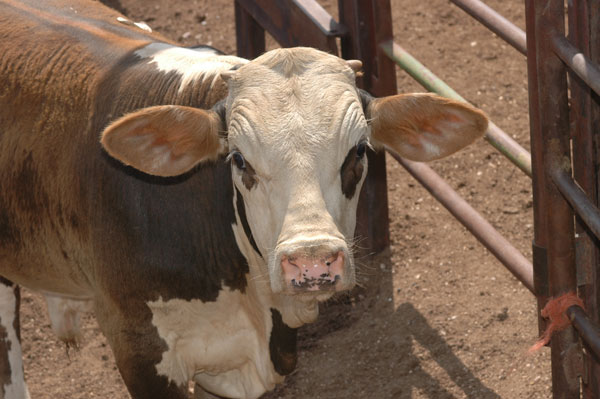“If price seasonality is intact, then there is more downside in the market this fall,” says Andrew P. Griffith, agricultural economist at the University of Tennessee, in his weekly market comments. “However, this fall is not going to be the worst of it. The cyclical nature of beef cattle prices could force the calf and feeder cattle market even lower the next couple of years.”
September 9, 2016

Sharply lower fed cattle prices and daily whipsawing by the futures market continued to pressure calf and feeder prices this week.
Feeder steers and heifers traded mostly $2-$6 per cwt lower, according to the Agricultural Marketing Service (AMS). Calves sold mostly $6-$15 lower. The AMS regional weighted average feeder steer price for 6-weight cattle declined $10-$17 in the last two weeks.
Although Feeder Cattle futures closed in a tame range week to week—65¢ to $1.00 lower in the front three contracts, and then narrowly mixed—there were daily triple digit swings along the way.
Cash fed cattle traded sharply lower as wholesale beef prices continued to erode. Live prices were mostly $5 lower at mostly $105 per cwt. Dressed trade was $4 lower in Nebraska at $166; as much as $8-$9 lower in Iowa-Minnesota at the same money in the beef.

70+ photos showcasing all types of cattle nutrition
Readers share their favorite photos of cattle grazing or steers bellied up to the feedbunk. See reader favorite nutrition photos here.
For all of that, week-to-week, Live Cattle futures were an average of $2.01 higher through the front three contracts ($1.30-$2.80) and then mostly narrowly mixed.
“It is abnormal for live cattle prices to continue finding new summer lows this late in the summer,” says Andrew P. Griffith, agricultural economist at the University of Tennessee, in his weekly market comments. He explains the summer low usually occurs in late June to early August as more cattle come off feed, and as consumer demand wilts in the summer heat.
This year, though, Griffith says, “The finished cattle market continues to find a way to decline as cattle feeders continue moving animals in a timely manner. Declining prices may be sending the wrong signal, but it may result in decent prices late in the fall.”
Week to week, Choice boxed beef cutout value was $3.19 lower at $187.90 per cwt. Select was $4.80 lower at $182.27.
Combined with apparent currentness in feedlot marketing, the silver lining to lower wholesale and retail beef prices is the opportunity to grow consumer beef consumption, if not demand.
“Declining cattle prices and wholesale prices have allowed restaurants and grocers to reduce beef prices the past few months,” Griffith explains. “As of July, the All-Fresh retail price of beef was $5.75 per pound, which is the lowest retail beef price since July 2014…The struggle for beef continues to be its relative price compared to competing meats.”
From 2006 through 2012, Griffith explains the All-Fresh retail price of beef was 1.3 times higher than the pork retail price and 3.3 times higher than the broiler retail price. From 2013 through July 2016, the beef-to-pork retail price ratio has averaged nearly 1.5 while the beef-to-broiler ratio is just above 3.7.
"The ratios for July 2016 were 1.5 and 4.0 for beef-to-pork and beef-to-broiler, respectively," Griffith says. "These ratios are important because consumers do use relative prices at the meat counter. Research has demonstrated that pork and chicken are weak substitutes for beef, but consumers are looking for ways to stretch every dollar."
In the meantime, AMS analysts said Friday, “Over the last four weeks, the lower trend in the cattle complex has taken the air out of the sails of most everyone in the industry.”
Cyclically speaking, those sails will likely remain limp for a while.
“If price seasonality is intact, then there is more downside in the market this fall,” Griffith says. “However, this fall is not going to be the worst of it. The cyclical nature of beef cattle prices could force the calf and feeder cattle market even lower the next couple of years.”
“Total daily August steer and heifer slaughter was 15.9% larger than last year (through August 20),” says David P. Anderson, livestock economist for Texas A&M AgriLife Extension Service, in the most recent In the Cattle Markets.
“Digging deeper in the data is even more interesting. Steer slaughter is up 13.4%. Heifer slaughter was up a whopping 22%, compared to August last year. The increase in steer slaughter suggests a rapid pace of marketings, perhaps providing the opportunity to avoid the marketing backup experienced last year. The pace of heifer slaughter and the total numbers may suggest some information on the pace of herd expansion. Total cow slaughter is 19% larger than a year ago. While dairy cow slaughter is up about 7% in August, 37% more beef cows went to slaughter,” Anderson says.
“From the buyer’s perspective, this fall may be a good time to purchase some high- quality cows or heifers to breed. The initial investment should be much lower as heifer prices continue to wane,” Griffith says. “Additionally, this fall should play well into stocker producers’ plans as it will not cost nearly as much to secure inventory. The key message is to manage costs and keep financial records to determine if the enterprise is profitable or losing money.”
You might also like:
Do small cows make more money?
13 utility tractors that will boost efficiency
How to get more value from your cull cows
14 thoughts to help get those heifers bred
Photo Tour: World's largest vertically integrated cattle operation
About the Author(s)
You May Also Like





